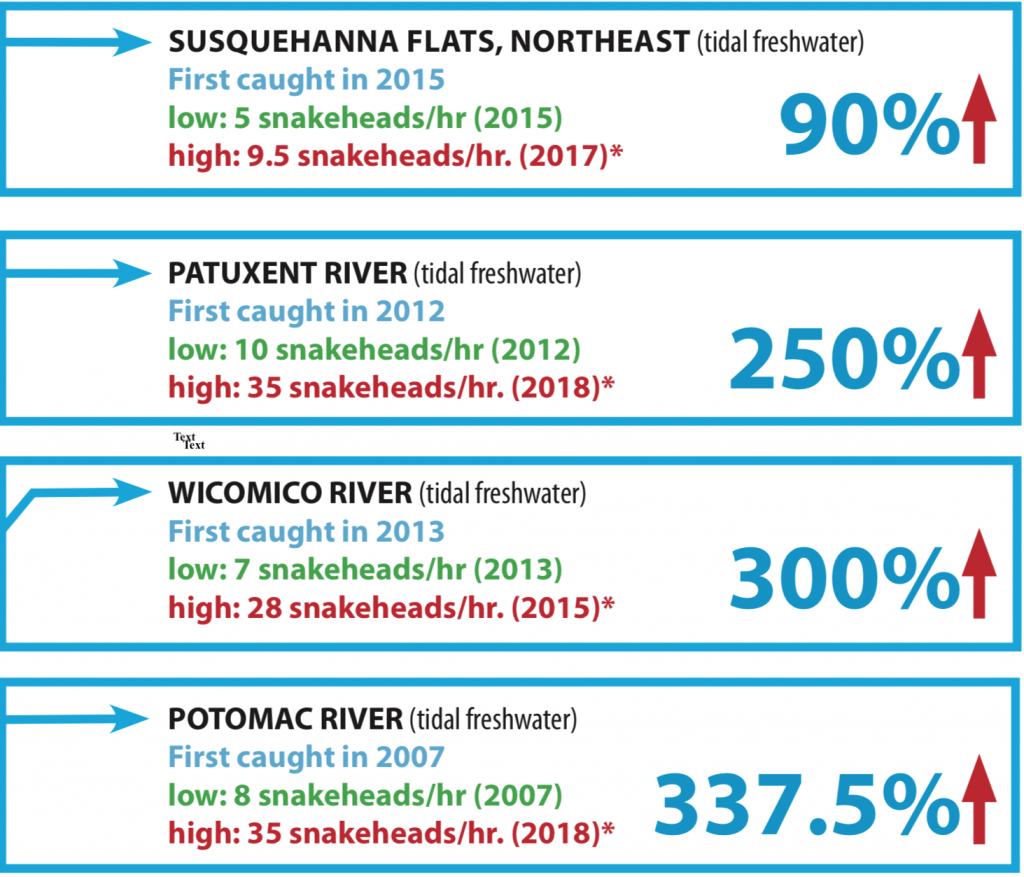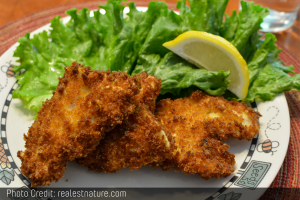About Us
Hi, my name is Anthony, I am a senior at Walt Whitman High School and I am a member of the Bethesda Green Environmental Leaders Program. For my final project as an intern at Bethesda Green, I created an educational platform in which users of all ages could learn about the Northern Snakehead species. I created the project with the help of my fellow intern, Sander Schulman.
Hi, my name is Sander. I am also a senior at Walt Whitman High School, working in the Environmental Leader’s Program. I have been interested in the effects of climate change on invasive species, specifically the Northern Snakehead. I also enjoy web design and worked with Anthony to create this interactive informational webpage on the snakehead and related species.
Habitat

Prime Snakehead Habitat – Nanjemoy Creek, MD. Courtesy of Bright MLS.
Northern Snakeheads favor freshwater streams, rivers, wetlands, or ponds and prefer low moving to stagnant waters with mud bottoms. They typically tend to prefer living at shallow depths less than 2.5 meters and salinity between 15-18 parts per thousand. They can live under the ice during cold winters and survive in low oxygen environments, and some are even able to breathe atmospheric oxygen. Furthermore, these fish can make their way out of the water and crawl short distances when transferring between two bodies of water becomes necessary. During their spawning season, which occurs between April and August, they move to shallower stagnant waters with heavier aquatic plant coverage. Nests are made by first clearing an area and then weaving aquatic vegetation into a column to hold and protect eggs.
Introduction & Spread
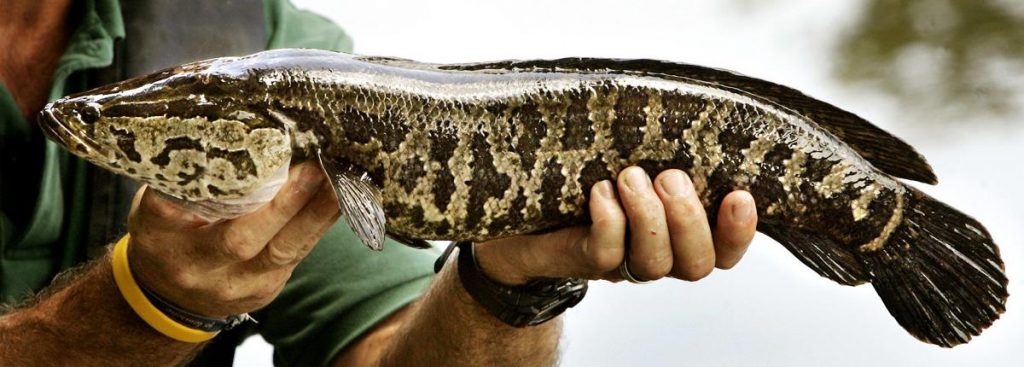
Northern Snakehead caught in a tributary of the Potomac River. Courtesy of Winston-Salem Journal
Snakeheads likely began their spread into the United States when aquarium owners discarded their unwanted exotic captive species into local waterways. The fish is also an important food source in other countries and could have been intentionally released into waterways to create a local food source for fisherman here in the United States. The species was first collected in the Potomac River in 2004 and has become successfully established in several major rivers within the Chesapeake Bay watershed.
Interactive Map
*Click on the plot points to see more information about each Snakehead sighting
Impacts (Environmental & Socioeconomic)
In recent years, Northern Snakeheads have been a growing threat to the Chesapeake Bay. They consume many types of microscopic organisms, crustaceans, and insect larvae that native fish, such as the Largemouth Bass rely on. Adult Snakeheads have been found to eat reptiles, crustaceans, small birds, and mammals. During their spawning seasons, Snakeheads become even more aggressive towards any species trespassing on their breeding ground.
Juvenile Snakehead Prey:
- Zooplankton
- Insect Larvae
- Small fish (Shad, Bluegill, Sunfish)
- Crustaceans populations (Crawfish)
Adult Snakehead Prey:
- Variety of Fish
- Crustaceans (Crawfish)
- Small Amphibians (Frogs, Salamanders, Newts)
- Reptiles (Snakes, Turtles)
- Some Birds and Mammals (Rodents, Water Fowl)
If not properly managed, Snakeheads have the capability to eliminate native fish species and damage aquatic ecosystems. In 2016, Maryland’s recreational bass anglers supported nearly 10,200 jobs and contributed 802 million dollars to state GDP. This represents 97% of the total economic value of the commercial and recreational bass fishery. In 2019 alone nearly 12.6 million dollars was made from the sales of fishing licenses (U.S. Fish and Wildlife Service). Local governments, such as ours, who depend on tourist dollars from recreational fishing and rely on food from commercial fishing could experience substantial losses if Northern Snakeheads continue to thrive in Chesapeake waters.
Actions Taken in Maryland

Snakehead Fishing Tournament: Photo Courtesy of Shannon Chambers Photography via Fish & Hunt Maryland
The Maryland Department of Natural Resources (DNR) has worked extremely hard with neighboring states to limit the further spread of the Northern Snakehead species. As with other invasive species, they have deregulated the harvest of the Northern Snakehead so more anglers can help keep the population under control. They also made it illegal to possess live Snakeheads in order to prevent anglers from spreading them to other bodies of water. Information networks, between both government agencies and the public, have been created to increase interagency efficiency and allow more opportunities for community input. To further promote the harvest of the Northern Snakehead, the DNR has implemented a variety of incentives targeted toward local anglers. Incentives include social media initiatives, seafood marketing to promote commercial harvest, as well as Snakehead fishing tournaments and awards.
Click here for the most recent Snakehead Management Plan
Coloring Page
Climate Change and the Northern Snakehead
Maryland is among the states most vulnerable to climate change due to its close proximity to the Atlantic Ocean. Rising water levels and increasing storm intensity have had disruptive and long-lasting economic and environmental impacts on the Chesapeake Bay, which poses a significant threat to the quality of natural life many Marylanders enjoy. Long-run temperature data shows that average annual temperatures in Maryland have considerably risen in the last century and without intervention, will likely continue to rise steadily over the next century.
Bay water has also been found to be two degrees warmer than in the 1960s, and while sea levels around the world are rising at the rate of about six inches every 100 years, the bay levels have increased almost a foot because of its naturally subsiding coastal land. Specific to the Snakehead and also relevant for catfish, one of the climate impacts is the increase and intensity of rain events and precipitation. 2018 was the wettest year on record. This increased rainfall reduces the salinity in the Maryland portion of the bay, and because both snakeheads and catfish are freshwater species, the decreased salinity allows these invasive species to explore and invade new areas. Also as the water warms, it holds less oxygen than cold water, so it can be expected that native fish species could struggle and get outcompeted by the snakehead, who are adapted to lower oxygen conditions. Overall, climate change is likely to allow for the expansion of snakeheads and other invasive fish species in the bay.
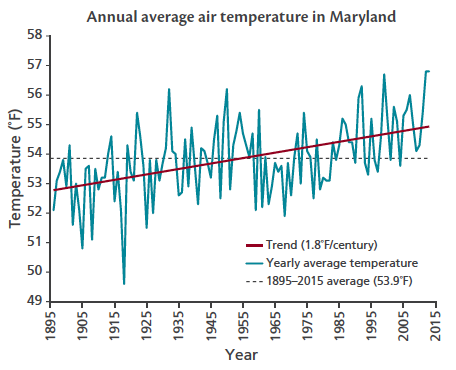
Data from the National Climatic Data Center illustrates that temperatures in Maryland have increased ~1.8ºF per century since 1895. Marylanders around the state have already been reporting warmer winter days, shorter winter months, more intense heat and humidity in the summer, and more damage due to storms.
Interviews

Image from Capital Gazette
Dr. Allison Colden
Chesapeake Bay Foundation- Invasive Species
Maryland Fisheries Scientist
Email: acolden@cbf.org
Phone: 757-615-9864
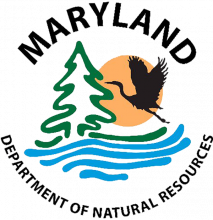
Dr. Joseph Love
Department of Natural Resources – Invasive Species
Northern Snakehead Biologist
Email: joseph.love@maryland.gov
Phone: 410-260-8257

Image from WAMU “Invaders In Our Midst”
Jonathon McKnight
Department of Natural Resources – Wildlife & Heritage
Exotic and Invasive Species Biologist
Email: jonathan.mcknight@maryland.gov
Phone: 410-260-8539
Catch & Cook
The Northern Snakehead is a delicious fish, with meat comparable to any flaky white fish such as Striped Bass, Halibut, Haddock, or even Whiting. According to the Department of Natural Resources, studies routinely demonstrate that Snakehead muscle contains insignificant levels of contaminants that are harmful to humans. Snakehead Fishing Guide
Scientific Studies
Technical Report: DIETS AND PREY PREFERENCE OF NORTHERN SNAKEHEAD
Written By: Joseph W. Love (Department of Natural Resources) and Joshua J. Newhard (U.S. Fish and Wildlife Service)
Link: https://dnr.maryland.gov/fisheries/Documents/PreyPreference_N_Snakehead.pdf
Synopsis: After conducting multiple observational experiments in controlled environments, scientists found that Snakeheads do not have any specific prey preference. “Snakeheads generally ate the most common aquatic prey, making multiple species potential targets. Snakeheads may also prefer to eat the most easily captured prey, but this hypothesis requires additional study.”
Technical Report: PREDICTED IMPACTS ON PREY BY NORTHERN SNAKEHEAD
Written By: Joseph W. Love (Department of Natural Resources) and Joshua J. Newhard (U.S. Fish and Wildlife Service)
Synopsis: Invasive aquatic species can cause ecological harm to biodiversity and economic hardships. Populations of Northern Snakehead were surveyed by boat electrofishing surveys that targeted them from spring through summer (2014-2015). After extensive surveying of Largemouth Bass and Northern Snakehead populations, scientists observed trends in the consumption patterns of Northern Snakehead. They discovered that the Northern Snakehead consumption rate was at an all-time high during the months of July and August. The consumption rate was also seen to decrease when the temperature surpassed the range of 6.6*C to 28.7*C. They concluded that Northern Snakehead populations can reduce biomass of multiple fish prey species through predation, and the impact will become more severe as the population increases.
Scientific Article: A Geospatial Approach for Estimating Suitable Habitat and Population Size of the Invasive Northern Snakehead
Written By: J.W. Love, B. Greenfield (Maryland Department of Natural Resources, Division of Inland Fisheries) and J.J. Newhard (U.S. Fish and Wildlife Service, Maryland Fishery Resources Office)
Link: https://dnr.maryland.gov/fisheries/documents/Love_Newhard_Greenfield-2015-NSnakehead.pdf
Synopsis: Estimating population size in order to assist in analyzing seasonal distributions of snakeheads in two tidal freshwater streams. Habitat models are useful in fisheries management for setting goals in conservation and predicting the population sizes of stream fishes. Results show data regarding how suitable habitat conditions are for the Snakehead seasonally. This data makes it easier for scientists to predict where an invasive species will thrive and likely move next.
Scientific Article: Genomic analyses of Northern snakehead (Channa argus) populations in North America
Written By: Carlee A. Resh, Matthew P. Galaska, and Andrew R. Mahon
Link: https://www.ncbi.nlm.nih.gov/pmc/articles/PMC5889702/
Synopsis: Genomic tools have become very important for the monitoring and early detection of rare species, it can provide information regarding the population structure of a species. Genetic tests have helped Scientists discover the source of the invasive Snakeheads. Ones found in the Lower Hudson River basin had a nearly identical gene structure to the ones in fish markets throughout New York, confirming the source. Populations in the Potomac River have more ancestral genotypes than those in Arkansas. An accurate assessment of current population size is crucial for conservation efforts and management, along with making accurate models of population growth. This is the first estimate of long-term effective population size for the Arkansas and East Coast populations using SNP data
Species Datasheet: Channa argus (northern snakehead)
Written By: CABI Invasive Species Compendium
Link: https://www.cabi.org/isc/datasheet/89026
Synopsis: The Northern Snakehead (Channa Argus) species is native to parts of southern and eastern China. In 2002, the species was found in Crofton, Maryland. It was purchased in New York and later released into Maryland waters (Kluger, 2002). Since its first sighting in Maryland, northern snakeheads are now thriving throughout the country and can be found in California, Florida, Maine, Maryland, Massachusetts, Arkansas, North Carolina, Rhode Island, and Wisconsin.






